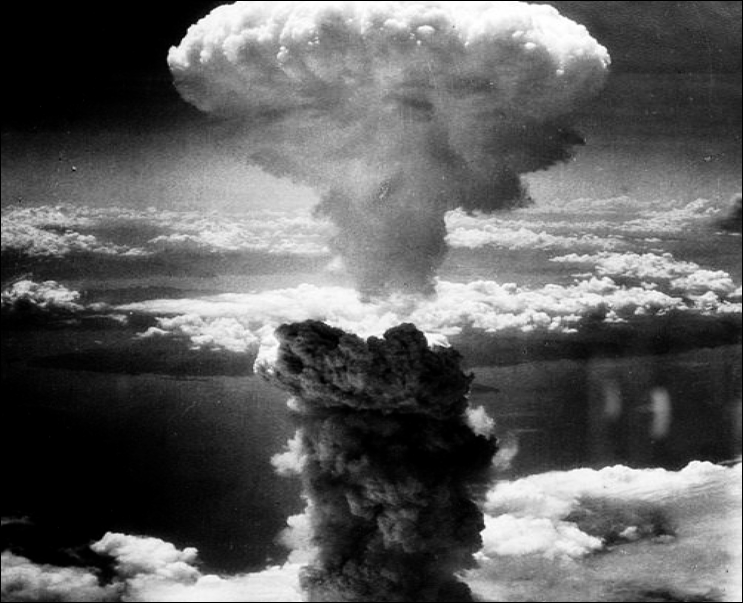Winner of the Spring 2017 StMU History Media Awards for
Best Article in the Category of “World History”
“We knew the world would not be the same. A few people laughed, a few people cried, most people were silent. I remembered the line from the Hindu scripture the Bhagavad Gita. Vishnu is trying to persuade the prince that he should do his duty and to impress him takes on his multiarmed form and says, ‘Now, I am become Death, the destroyer of worlds.’ I suppose we all thought that one way or another.”1
- J. Robert Oppenheimer, The Decision to Drop the Bomb

Throughout the history of human warfare, conflict has pushed humans to innovate–to build ever larger and deadlier weapons, each more lethal than the last. However, it was not until World War II and the invention of the atomic bomb that humanity has been able to kill on such a massive and efficient scale. Case in point, in the final days of World War II, the United States carried out one of the most chilling instances of mass murder in the history of humanity: the bombing of the Japanese cities of Hiroshima and Nagasaki. These attacks ultimately killed an estimated 294,000 people, the majority of whom were noncombatants.2 In comparison, the Japanese attack on Pearl Harbor killed just 2,408 American citizens, although this is largely due to the focused Japanese attack on military targets, namely the Pacific fleet and U.S. airfields.3 To give a more modern frame of comparison, the terrorist attacks against the World Trade Center and Pentagon, considered to be by far the worst terrorist attacks against the United States, claimed the lives of 2,974 American citizens.4
In the spring of 1945, World War II was entering its final stages. The Allies had already achieved victory in Europe with Germany’s surrender on May 7th, but the conflict on the Pacific front was still going strong. In the years leading up to the two World Wars, Japan’s victories against two larger countries–China in the Sino-Japanese War (1894–1895) and Russia in the Russo-Japanese War (1904–1905)–combined with other factors, forged a strong sense of Japanese nationalism, militarism, and cultural superiority. This fervent nationalism, integrated with the Japanese warrior ethic known as bushido, made the prospect of a Japanese surrender unlikely, even as the Allies began to position for an invasion of the Japanese mainland.5

Concurrently, since as early as 1942, President Franklin Delano Roosevelt had been secretly sponsoring and funding The Manhattan Project, the code name used for the $2 billion U.S. effort to develop a nuclear weapon before the Germans. A team of top physicists led by Dr. Julius Robert Oppenheimer were assigned to this project, a task so secret that not even individuals as important as then Vice President Harry S. Truman was aware of it. Shortly after Roosevelt’s untimely death and Truman’s subsequent inauguration to the presidency in April 1945, he was informed that the Manhattan Project was approaching success–that a nuclear weapon would be feasible in just four short months.6
Faced with the prospect of a costly and deadly invasion of Japan, Truman and his advisors were faced with a difficult choice: utilize this new atomic weapon or try to defeat Japan through conventional means. In late July, the United States issued the Postdam Declaration, a statement which gave Japan the choice between unconditional surrender or total annihilation. When this declaration went ignored, President Truman authorized the use of the atomic bomb.7

On the morning of August 6, 1945, Colonel Paul Tibbets piloted the Enola Gay over the city of Hiroshima, where his crew dropped an atomic bomb code-named “Little Boy.” Upwards of 70,000 people died instantly in the blast. Additionally, 48,000 buildings were destroyed and another 22,000 were damaged, leaving only 6,000 buildings untouched. Three days later, on August 9th, a second bomb was dropped onto Nagasaki, killing another 36,000 people. In total, an estimated 295,000 were killed in the blasts or from complications from the resulting nuclear fallout.8
Emperor Hirohito ordered the surrender of Japan on August 10, 1945. On August 15th, radios across Japan broadcasted Hirohito’s words as he read the declaration of surrender to the Japanese people, thus ending World War II. The bombs’ effectiveness in forcing the Japanese to surrender is still subject of popular debate among historians to this day, given that the Russian invasion of Japan-controlled Manchuria occurred at the same time of Nagasaki, both of which likely impacted Japan’s will to continue fighting.9 Even so, while the political and military effects of these blasts may be debated, none can contest their tragedy and devastation.

- Jason Pontin, “Oppenheimer’s Ghost,” MIT Technology Review, October 15, 2007. https://www.technologyreview.com/s/408835/oppenheimers-ghost/. ↵
- Dennis W. Cheek, “Hiroshima and Nagasaki,” in Encyclopedia of Science, Technology, and Ethics, edited by Carl Mitcham, Vol. 2, Detroit: Macmillan Reference USA, 2005. Gale Virtual Reference Library (accessed February 6, 2017), 923. ↵
- Sonia Benson, Daniel E. Brannen, Jr., and Rebecca Valentine, “Pearl Harbor Attack,” in UXL Encyclopedia of U.S. History, Vol. 6, Detroit: UXL, 2009. Gale Virtual Reference Library (accessed February 6, 2017), 1208. ↵
- Stefan M. Brooks, “September 11 Attacks,” in The Encyclopedia of Middle East Wars: The United States in the Persian Gulf, Afghanistan, and Iraq Conflicts, edited by Spencer C. Tucker, Vol. 3, Santa Barbara, CA: ABC-CLIO, 2010. Gale Virtual Reference Library (accessed February 6, 2017), 1096. ↵
- “The United States Drops the Atomic Bomb on Hiroshima and Nagasaki,” in Global Events: Milestone Events Throughout History, edited by Jennifer Stock, Vol. 2, Asia and Oceania, Farmington Hills, MI: Gale, 2014. Gale Virtual Reference Library (accessed February 5, 2017), 361. ↵
- “An Overview of the Atomic Bombings of Hiroshima and Nagasaki,” in The Atomic Bombings of Hiroshima and Nagasaki, edited by Sylvia Engdahl, Perspectives on Modern World History, Detroit: Greenhaven Press, 2011. Gale Virtual Reference Library (accessed February 6, 2017), 13-14. ↵
- “An Overview of the Atomic Bombings of Hiroshima and Nagasaki,” in The Atomic Bombings of Hiroshima and Nagasaki, edited by Sylvia Engdahl, Perspectives on Modern World History, Detroit: Greenhaven Press, 2011. Gale Virtual Reference Library (accessed February 6, 2017), 14-15. ↵
- Dennis W. Cheek, “Hiroshima and Nagasaki,” in Encyclopedia of Science, Technology, and Ethics, edited by Carl Mitcham, Vol. 2, Detroit: Macmillan Reference USA, 2005. Gale Virtual Reference Library (accessed February 6, 2017), 923. ↵
- “The United States Drops the Atomic Bomb on Hiroshima and Nagasaki,” in Global Events: Milestone Events Throughout History, edited by Jennifer Stock, Vol. 2, Asia and Oceania, Farmington Hills, MI: Gale, 2014. Gale Virtual Reference Library (accessed February 5, 2017), 361. ↵



152 comments
Alexis Renteria
The article was very informative and gave me a more clear understanding of the bombings on Hiroshima and Nagasaki. Your way of writing made it easy to follow, be engaged in the article as well as inform the reader of the Manhattan project. The fact that so many civilians were killed shows how innocent people get in the crossfire of conflicts all around the world and most of all brings up the question; was dropping the nuclear bombs the right decision?
Nahim Rancharan
This article was excellently organized. I like how you managed to capture the attention of your audience through the combined usage of sources and appropriate imagery. I was drawn while reading the article because your images provided a sense of visualization to the story of the two bombings in Japan. I could picture the severity of such a catastrophic situation, which is what it was. The United States effectively brought into play a new era of War tactics and it has revolutionized the way the world handles its defense protocols. Great Job on the article!
Anayeli Prieto
First off I’d like to start off by saying that this was a very interesting article . I would like to point out that I don’t understand how someone could not be emotionally affected by planting these bombs in Hiroshima and Nagasaki and possibly killing millions of innocent people that had nothing to do with war. I feel like this is a major issue in politics where the public and citizens are always the ones that are getting dragged into the problems that we don’t even create and we are the ones that pay the consequences that the politicians created in the first place. I love these current examples is Donald Trump and his attempt to create and start a war with Russia and China and we living in the US having to be protective of our country when we didn’t even begin the conflict.
Nicolas McKay
This was no doubt one of the most defining moments in human history. I wonder what Paul Tibbets thought when he and his men dropped the bomb over Nagasaki, and what they thought after they had carried out their mission, as the death toll began to roll in. It is incredible that they were bale to keep something like the Manhattan project under wraps, even from he vice president himself. It is interesting to wonder if Truman made the right choice dropping it, and perhaps what would have happened if he didn’t. Great job once again. This article is definitely deserving of an award.
Marissa Gonzalez
I loved how much research you put into your article. I also thought it was a good idea to introduce your article with the quote by J. Robert Oppenheimer. It is sad to read about the many lives that were lost because of this and makes a great impact on the relationships between the United States and other nations. It really makes me wonder if there will be other situations like this in the future. Great research!
Irene Astran
I have always felt that the bombs that were dropped on Hiroshima and Nagasaki were overkill. There was no distinguishing who was the enemy and who was the victim, I know. However, it is very off putting that so many innocent men, women, and children were caught in the crossfire. This is a very ugly point in the United States’ history in my opinion.
Sergio Cervantes
I found the introduction of the article to be chilling to the bone because of the fact that these words were spoken by the leader of the Manhattan Project. I did not realize the devastation that these bombs brought to Japan until I read the numbers of casualties listed. It amazes me that humans are capable of such destruction and annihilation in an instant. It must have been difficult for Pres. Truman at the time to decide to go through with the bombings of two Japanese cities.
Ana Gonzalez
Great job Cameron, you do a great job of using your research and developing it into a fascinating story. I enjoy reading your articles and your powerful language always grabs my attention. I hope your articles receive many awards, for they are very nicely written.
As for your topic, I hope that no country ever decides to launch a nuclear bomb into a another, because in my opinion, any type of conflict and tension can be resolved through diplomacy, not destruction.
Thank you for your articles!
Zaraly Frasquillo
Opening with a Robert Oppenheimer quote? Yes, great idea, it made your introduction by far one of the best intros on this website. Okay, so before reading your article my knowledge on all of the bombings that occurred was not very extensive, I honestly just thought there was big bomb that was dropped. But now that I know what truly happened, it make me rethink the situation. As Americans we know that we have a lot of power but we do not really realize how powerful we are, and your article made me realize we are extremely powerful. Thank you Cameron!
Gabriela Medrano
I agree with many that the take you had on this tragedy in history was different from the ones we normally read about. I see it in this way, because the bombs were a no-no on part of the U.S, people turned a blind eye to the destruction left behind and changed its realities to a victory instead of what it truly was. You took on this topic like if this was your specialty and i think that made the read much easier. Normally, the articles based on this are a boring read, so good job! Awesome article